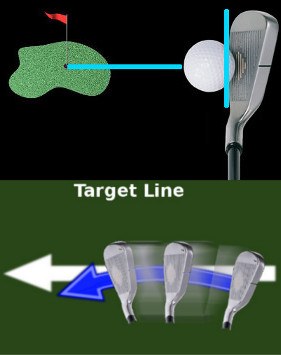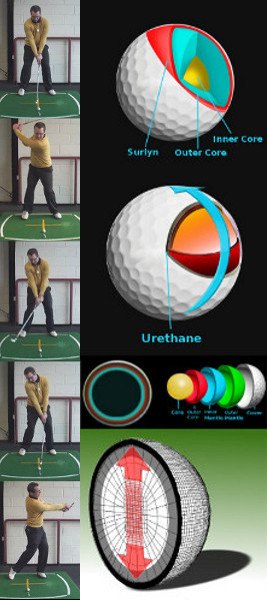
When you are trying to decide which golf ball model to add to your bag, the topic of compression is one that you will want to consider. In the golf world, this is something of a controversial topic, as there is no agreement with regard to whether or not compression is actually an important ball fitting factor. Does compression really make a difference when trying to pick the right ball for your game? It’s hard to say. Some people seem to believe that it is an important factor, while others think that it shouldn’t be part of the equation. In the end, you’ll have to decide for yourself whether or not you think compression needs to be part of your ball selection process.
As the name would suggest, ‘compression’ – in the golf sense, at least – refers to how much the ball compresses against the face of the club at impact. In general, golf balls are divided up into three compression categories, low, mid, and high. All else being equal, it will take a lower swing speed to compress a ball with a ‘low’ rating than it will to compress a ball with a ‘high’ rating. In other words, most golfers will be able to compress a ball with a low rating to a greater degree than they can compress a ball with a high rating. And, with increase compression can come high ball speeds off the face, and greater distances.
So, shouldn’t everyone use a low compression ball? Wouldn’t that lead to optimal distance? No – probably not. Unfortunately, compression is a complicated topic with regard to how it will affect your ball flight. Sure, a lot of compression and a high ball speed sounds great, but those characteristics may come along with some negative characteristics that could cause problems. For instance, you are likely to see a high spin rate with a low compression ball, especially if you have a high swing speed. The way your swing interacts with the golf ball is complicated, and it certainly can’t be boiled down to a single rating like compression.
In this article, we are going to attempt to bring some clarity to the matter of compression. If you are going to reach your potential on the course, you need a golf ball that is a good match for your game. By educating yourself on the topic of golf balls, you’ll have a better chance to pick out the right one during your next visit to the pro shop. With that said, you will probably need to go through some experimentation before you find the perfect ball, even if you have narrowed down the list by doing some homework.
All of the content in this article has been written from the perspective of a right-handed golfer. If you happen to play left-handed, please take a moment to reverse the directions as necessary.

Distance First
When most people think or talk about the topic of compression, they are concerned with distance. They want to hit the ball farther, of course, and they think that picking out a ball with the right compression is going to help them do just that. Specifically, they often think that moving to a ball with a lower compression is going to make it easier to compress the ball at impact (which is true), and the ball will then rebound off the face more aggressively as it zooms off into the distance. This line of thinking isn’t necessarily wrong, but it is far too simplistic.
To think that compression is the only issue that affects the distance of your shots would be incorrect, as you would be overlooking the hugely important topic of spin (along with other factors). The spin rate you achieve on a given shot is going to have a lot to do with eventual distance, as it is going to impact the way the ball flights through the air. A high-spin shot will generally climb high into the sky, as the backspin provides the shot with lift. On the other hand, a shot with very little spin will have trouble getting off the ground at all. Most of the time, when trying to maximize distance, you are going to want to find yourself somewhere between these extremes. You don’t want a ball that is spinning at an incredibly high rate, but you don’t want to see extremely low numbers, either. A moderate spin rate – along with a good launch angle and other measurable – will lead to your best possible distance outcomes.
As an example of why you can’t look only at compression when picking a golf ball, let’s imagine that a powerful, skilled player decided to use a ball on the low end of the compression scale. At impact, this powerful player would be able to smash the ball impressively, with the shape of the ball flattening out dramatically before it rebounds off the face and takes off. So, this shot would travel a great distance, right? Probably not. In addition to the tremendous compression seen at impact, it is nearly certain that there would be a ton of backspin created. The shot will most likely fly incredibly high, but it wouldn’t cover that much in terms of horizontal distance. Much of the power created at impact would be wasted sending the ball higher and higher, meaning the shot as a whole would be rather underwhelming when all was said and done.
There is nothing wrong with chasing distance by picking the right golf ball for your game. Some golfers are too obsessed with adding yards, but there can be no debate that hitting the ball farther will help you be a better player (assuming you maintain control over those shots, of course). With that said, you can’t just move down to a softer compression and think you are going to be launching shots into the distance. It just doesn’t work that way. Instead, you need to look for a golf ball that matches up with all of your needs. In other words, you want a ball that you can compress nicely at impact without generating too much spin. You don’t want to have to work too hard to smash the ball against the face, but you also don’t want that to come too easy, either. The ball that matches up best with your existing abilities is likely the one which will offer optimal performance.

Proper Testing
Fortunately, much of the golf ball guesswork has been taken out of the modern game, thanks to technology. These days, if you need to pick a golf ball, you don’t have to buy a sample of every ball on the market in order to test them all out on the course. Instead, you can just contact your local golf shop or golf course about a ball fitting session. Most golf facilities today have the equipment needed to put you through a high-tech ball fitting, and this service is usually offered at a modest cost (similar to the cost of a golf lesson, usually). Not only will a ball fitting help you pick the right golf ball model for your needs, but going through this process is likely to teach you plenty of other things about your game.
There will be a number of different pieces of information collected when you make swings in front of the computer. Your swing speed will be measured, as well as your angle of attack, swing path, and much more. The information could easily be intimidating if you were looking at it all alone, but the fitting professional working with you should be able to cut through the confusion. With the help of a qualified professional, you can quickly learn from all of the data that has been collected, and you’ll be well on the way to picking out the right ball.
If you do decide to sign up for a ball fitting session, there are a few tips we can offer to help you get the best possible results from the process. Those tips are listed below –
- Be honest. The person performing the ball fitting is likely to ask you a number of questions about the current state of your game. It is essential that you are honest during this process. If your answers are not quite truthful, the final outcome of the process will not be what you had hoped. For instance, if asked for your average score, give a truthful representation of your current game, not what you would like it to be. The fitting pro is there to help you, but he or she can only do their job if you give them the accurate info needed to find the proper conclusions.
- Use your normal swing. This next point continues on with the theme of honesty. It will be tempting to add a little ‘oomph’ to your swing when hitting shots in front of a launch monitor, as you will want to register the best possible numbers. You might have fun trying to impress the computer, but this is a mistake, of course. By changing your swing and being more aggressive than you would be out on the course, the measurements gathered by the launch monitor aren’t going to be particularly useful. The goal here is to pick the right ball for use on the course, so you should be trying to use the exact same swing that you’ll employ during your rounds. Forget about trying to impress the computer (or the fitting pro) and just make your normal swing.
- Ask plenty of questions. You want to make sure you understand everything that is going on during the fitting process. It won’t do you any good to just nod along as the fitting professional is explaining things which you don’t understand. When something come up that is unfamiliar to you, ask questions and make sure you are clear on what it is and why it’s important. In the end, adding to your overall golf knowledge may be one of the biggest benefits of going through a fitting process.
When your ball fitting session is finished, you should have a list of golf balls to consider. These balls will be recommended based on the dynamics of the swing, in addition to the information you have provided the fitting pro. You are still free to pick whatever ball you want, of course, but the recommendations from the fitting process will give you a nice place to start. Rather than trying to consider all of the balls on the market, which would be overwhelming, you can use the help of a fitting session to narrow down the contenders before moving on to the next step.
Getting back to the topic of compression, you can see how going through a fitting process can help to take any questions about compression out of the picture. You won’t have to try to determine which compression is best for your game, or even what the compression rating is for various balls, because you can simply use the fitting to guide your decisions. These days, most golf balls don’t list their compression rating on the ball (as they often did in days gone by) because that piece of information simply isn’t used by most modern players.





